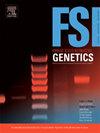在FSWG-ISFG实验室间比较中,用于评估法医DNA混合物价值的命题
IF 3.1
2区 医学
Q2 GENETICS & HEREDITY
引用次数: 0
摘要
DNA 解释依赖于在至少两个相互排斥的命题下对结果进行评估。本研究评估了国际法医遗传学协会(ISFG)关于在六个国家的 15 个实验室中提出此类命题的建议的应用情况,并研究了在考虑两个利益相关者时如何进行评估。在一次由 ISFG 法语工作组组织的实验室间比对中,他们被要求对考虑到 DNA 来源建议的结果进行评估。本文重点讨论一个模拟案件中的 DNA 混合物,该案件涉及一名申诉人和两名相关人员。在 ISFG 的八项建议中,有七项适用于此次实验室间比对,其中六项被所有实验室采纳。然而,当提交两名利益相关者进行比对而不提供进一步的案件信息时,只有七家实验室遵循了建议 3,为每个潜在的促成因素分配了不同的似然比 (LR)。其中一家实验室使用了多重命题(两个以上相互排斥的命题),认为每个人都可能是或不可能是 DNA 的来源,无论是否有另一个人。其余 8 个实验室只分配了一个 LR,认为两个人都是贡献者,或两个人都不是。如 ISFG 建议所述,应避免这种做法,因为它可能导致高估其中一个贡献者的 LR。我们还展示了考虑或不考虑 DNA 混合物中无争议人员 DNA 的存在(即以无争议来源的 DNA 图谱作为 DNA 结果的 "条件")对 LR 的影响。当在基本真相实验中应用 "条件 "时,结果会对已知为真的命题提供比替代命题更有力的支持。更确切地说,根据实验室的不同,在进行调节时,LR 值会增加 100-10'000 倍。本文介绍了两个真实案例中的 LR 值,以说明在评估结果时需要考虑新信息,如 DNA 混合物中存在潜在贡献者,以及在考虑多个相关人员时需要考虑多个命题。这会极大地改变 LR 值。本文章由计算机程序翻译,如有差异,请以英文原文为准。
Propositions used to assess the value of forensic DNA mixtures in an FSWG-ISFG interlaboratory comparison
DNA interpretation relies on the evaluation of results under at least two mutually exclusive propositions. This study evaluates the application of the International Society for Forensic Genetics (ISFG) recommendations concerning the formulation of such propositions across 15 laboratories in six countries and examines how evaluations are conducted when two persons of interest are considered. They were asked to assess results considering propositions about the source of the DNA during an interlaboratory comparison organized by the French Speaking Working Group of the ISFG. This article focuses on a DNA mixture from a mock case involving a complainant and two persons of interest. Seven of the eight ISFG recommendations were applicable to this interlaboratory comparison, with six being implemented by all laboratories. However, when two persons of interest were submitted for comparison without further case information, only seven laboratories followed Recommendation 3 by assigning a different likelihood ratio (LR) to each potential contributor. One of them used multiple propositions (more than two mutually exclusive propositions) and considered that each person, in turn, could or could not be the source of the DNA with or without the other person. The eight remaining laboratories assigned only one LR considering that both persons were contributors, or neither. As stated in the ISFG recommendations, such a practice should be avoided as it could lead to an overestimation of the LR for one of the contributors. We also demonstrate the effect of considering, or not, the presence of the DNA of persons whose contribution to the DNA mixture was not disputed (i.e., "conditioning" the DNA results on the DNA profiles of the undisputed source) on the LR. When conditioning is applied in ground truth experiments, the results provide stronger support for the proposition known to be true compared to the alternative. More precisely, the LR increased by a factor of 100–10’000 when conditioning, depending on the laboratory. The LRs assigned in two real cases are presented to illustrate the need to consider new information, such as the presence of a potential contributor to a DNA mixture, when evaluating results, and multiple propositions when several persons of interest are considered. It can significantly change the LR value.
求助全文
通过发布文献求助,成功后即可免费获取论文全文。
去求助
来源期刊
CiteScore
7.50
自引率
32.30%
发文量
132
审稿时长
11.3 weeks
期刊介绍:
Forensic Science International: Genetics is the premier journal in the field of Forensic Genetics. This branch of Forensic Science can be defined as the application of genetics to human and non-human material (in the sense of a science with the purpose of studying inherited characteristics for the analysis of inter- and intra-specific variations in populations) for the resolution of legal conflicts.
The scope of the journal includes:
Forensic applications of human polymorphism.
Testing of paternity and other family relationships, immigration cases, typing of biological stains and tissues from criminal casework, identification of human remains by DNA testing methodologies.
Description of human polymorphisms of forensic interest, with special interest in DNA polymorphisms.
Autosomal DNA polymorphisms, mini- and microsatellites (or short tandem repeats, STRs), single nucleotide polymorphisms (SNPs), X and Y chromosome polymorphisms, mtDNA polymorphisms, and any other type of DNA variation with potential forensic applications.
Non-human DNA polymorphisms for crime scene investigation.
Population genetics of human polymorphisms of forensic interest.
Population data, especially from DNA polymorphisms of interest for the solution of forensic problems.
DNA typing methodologies and strategies.
Biostatistical methods in forensic genetics.
Evaluation of DNA evidence in forensic problems (such as paternity or immigration cases, criminal casework, identification), classical and new statistical approaches.
Standards in forensic genetics.
Recommendations of regulatory bodies concerning methods, markers, interpretation or strategies or proposals for procedural or technical standards.
Quality control.
Quality control and quality assurance strategies, proficiency testing for DNA typing methodologies.
Criminal DNA databases.
Technical, legal and statistical issues.
General ethical and legal issues related to forensic genetics.

 求助内容:
求助内容: 应助结果提醒方式:
应助结果提醒方式:


